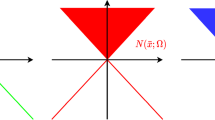Abstract
Representations of composite systems, such as bilinear programming, models of consumer/producer behavior, and sensitivity problems involve bifunctions (functions of two vector arguments). Such bifunctions are typically convex, pseudoconvex, or quasiconvex in each of their arguments, but not jointly convex, pseudoconvex, or quasiconvex. These functions do not in general possess the strong local-global property, namely, that every stationary point is a global minimum. In this paper, we define conditions that ensure that a bifunction possesses only a global minimum. In exploring this question, we use P-convexity and pseudo P-convexity, which are classes of bifunctions that generalize quasiconvexity and pseudoconvexity.
Similar content being viewed by others
References
Crouzeix, J. P., andLindberg, P. O.,Additively Decomposed Quasiconvex Functions, Mathematical Programming, Vol. 35, pp. 42–57, 1986.
Debrue, G., andKoopmans, T. C.,Additively Decomposed Quasiconvex Functions, Mathematical Programming, Vol. 24, pp. 1–38, 1982.
Yaari, M. E.,A Note on Separability and Quasiconcavity, Econometrica, Vol. 45, pp. 1183–1186, 1977.
Hackman, S. T., andPassy, U.,Projectively-Convex Sets and Functions, Journal of Mathematical Economics, Vol. 17, pp. 55–68, 1988.
Al-Khayyal, F. A.,Biconvex Programming and Biconcave Minimization, D.Sc. Dissertation, Department of Operations Research, George Washington University, Washington, DC, 1977.
Altman, M.,Bilinear Programming, Bulletin de l'Academie Polonaise des Sciences, Serie des Sciences Mathematiques, Astrophysiques et Physiques, Vol. 16, pp. 741–746, 1968.
Kyparisis, J., andFiacco, A. V.,Generalized Convexity and Concavity of the Optimal Value Function in Nonlinear Programming, Mathematical Programming, Vol. 39, pp. 285–304, 1987.
Luenberger, D. G.,Quasiconvex Programming, SIAM Journal on Applied Mathematics, Vol. 16, pp. 1090–1095, 1968.
Rockafellar, R. T.,Convex Analysis, Princeton University Press, Princeton, New Jersey, 1970.
Behringer, F. E.,Discrete and Nondiscrete Quasiconvexlike Functions and Single Peakedness (Unimodality), Operationsforschung und Statistik, Series Optimization, Vol. 14, pp. 163–181, 1983.
Danskin, J. M.,The Theory of Max-Min, Springer-Verlag, New York, New York, 1967.
Chabrillac, Y., andCrouzeix, J. P.,Definiteness and Semidefiniteness of Quadratic Forms Revisited, Linear Algebra and Its Applications, Vol. 63, pp. 283–292, 1984.
Diewert, W. E., Avriel, M., andZang, I.,Nine Kinds of Quasiconvexity and Concavity, Journal of Economic Theory, Vol. 25, pp. 397–420, 1981.
Crouzeix, J. P., andFerland, J. A.,Criteria for Quasiconvexity, Mathematical Programming, Vol. 18, pp. 349–352, 1981.
Schaible, S.,Quasiconvex, Pseudoconvex, and Strictly Pseudoconvex Quadratic Functions, Journal of Optimization Theory and Applications, Vol. 35, pp. 303–338, 1981.
Berge, C.,Topological Spaces, Macmillan Publishers, New York, New York, 1963.
Author information
Authors and Affiliations
Additional information
Communicated by M. Avriel
Rights and permissions
About this article
Cite this article
First, Z., Hackman, S.T. & Passy, U. Local-global properties of bifunctions. J Optim Theory Appl 73, 279–297 (1992). https://doi.org/10.1007/BF00940182
Issue Date:
DOI: https://doi.org/10.1007/BF00940182




